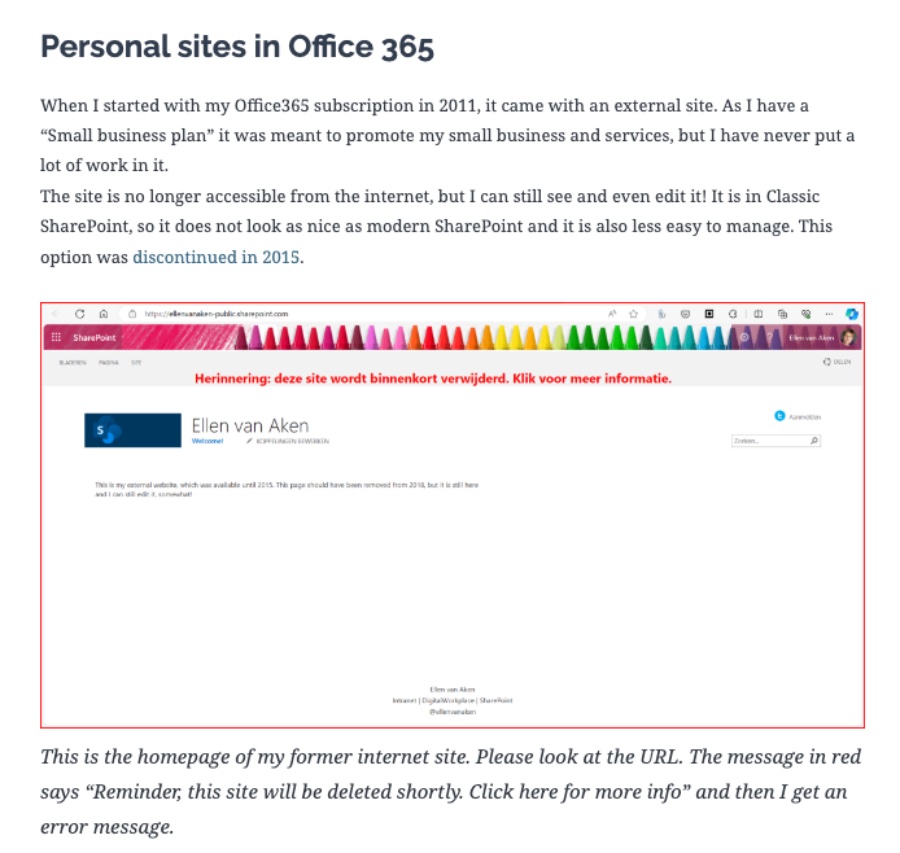
Reviving the Magic: SharePoints Role in Todays Internet
Rediscover SharePoints Forgotten Era of Internet Sites - A Nostalgic Journey!
Key insights

- SharePoint was once used for creating internet sites, a use that is likely unknown to those who started after 2015.
- By 2009, organizations were moving their brand and product websites to SharePoint to leverage Microsoft tools and reduce costs.
- Despite its capabilities, SharePoint faced criticism for its aesthetics and functionality for internet sites from marketing and sales departments.
- The author reminisces about a project aimed to transition websites to SharePoint but left before its completion. Microsoft phased out the website options in 2015, recognizing that other platforms offered better solutions.
- Until 2015, Office 365 subscriptions included an external site option, which has since been discontinued but can still be managed in Classic SharePoint mode.
In an era where the digital workplace continuously evolves, the use of SharePoint for creating and managing internet and external-facing websites stands out as a notable, albeit phased-out, chapter in its history. SharePoint, a versatile platform developed by Microsoft, primarily serves as a document management and storage system but has journeyed through various functionalities since its inception. Initially, it offered capabilities for hosting brand and product sites, shedding light on Microsoft's aim to provide a comprehensive toolset that catered not only to internal collaboration needs but also to broader marketing and online presence ambitions.
Despite SharePoint's adaptability, it faced challenges, particularly regarding its acceptance for internet site development. Criticisms focused on its design and functionality constraints, reflecting a broader dilemma between leveraging existing IT investments and meeting the dynamic, and often visually driven, demands of online marketing and sales strategies. However, this endeavor also mirrored the evolving landscape of digital solutions, where specialized platforms increasingly outpaced generalist tools in certain domains.
As Microsoft phased out SharePoint's website functionalities in 2015, the narrative underscores a shift towards specialization in digital tools and platforms. While SharePoint's versatility is undisputed in collaboration and intranet contexts, the evolution of digital marketing tools calls for more focused and tailored solutions. This development not only highlights the importance of aligning tools with specific business needs but also reflects the broader trend of digital transformation, where platform specialization and ecosystem integration become critical for achieving efficiency and impact in the digital age.
Reflecting on SharePoint's Evolution in the Digital Workplace
SharePoint's journey from a platform that supported internet site creation to its current focus emphasizes the fluid nature of digital workplace technologies. As organizations navigate the complexities of digital transformation, the shift toward specialized tools over general-purpose platforms like SharePoint for external-facing sites illustrates the need for a strategic alignment between technology and business objectives. In this evolving landscape, SharePoint remains a cornerstone for internal collaboration, while the pursuit of excellence in digital presence increasingly relies on targeted solutions that offer advanced capabilities and better user experiences. This narrative not only sheds light on SharePoint's adaptive journey but also signals the ongoing evolution of digital workplace ecosystems towards more segmented and purpose-driven technologies.
Read the full article SharePoint: the good old intERnet days

Did you know that SharePoint used to allow the creation of internet sites? This is something users who have been with SharePoint since 2008 or earlier might remember, while newer users might not be aware. To celebrate SharePoint's 23rd birthday, let's delve into its history with internet sites. Unlike just sharing sites and documents with business partners, SharePoint once enabled the creation of actual websites.
Back in 2009, during a significant project at my previous organization, we decided to move all our brand and product websites to SharePoint. The main reasons included making full use of our investment in Microsoft tools, having more control over hosting and maintenance, and saving costs. Despite initial resistance from the Marketing and Sales department, fearing the websites would "look like SharePoint," the transition aimed at maximizing efficiency and maintaining high design standards through our partnership with a web and brand design agency.
However, the expected transition to SharePoint for websites had to be reevaluated when, in 2015, Microsoft discontinued the website creation options on SharePoint after acknowledging that other platforms could provide better internet and website services. This story reflects the evolving nature of SharePoint and its capabilities, leaving users curious about the experiences of others who ventured into websites-on-SharePoint.
Moreover, with my Office 365 subscription initiated in 2011, I received an external site option tailored for promoting my small business. Although less accessible now and less user-friendly than the modern SharePoint, it showcases the evolution from Classic to Modern SharePoint. Despite these changes, SharePoint has maintained its functionality for external sharing with business contacts, although it differs from creating a publicly accessible internet site.
Exploring SharePoint's Evolving Landscape
The journey of SharePoint Online as a platform for creating internet websites has seen significant evolution. Initially embraced for the potential to use SharePoint Online for internet sites, organizations embarked on ambitious projects to consolidate brand and product websites onto the platform. This phase not only demonstrated SharePoint's flexibility but also its limitations, eventually leading to Microsoft discontinuing the feature in favor of platforms specifically tailored for web development.
Personal and small business users of SharePoint Online also felt the impact of these changes. The discontinuation in 2015 of the external site options provided under Office365 subscriptions marked a shift towards more specialized services for website hosting and development, highlighting the platform's transition towards optimizing its core strengths in collaboration and document management rather than acting as a one-size-fits-all solution.
Despite these shifts, the essence of SharePoint Online as a tool for enabling collaboration and sharing with external partners remains intact. Today, SharePoint Online continues to offer a robust platform for sharing documents, sites, and forms with external business contacts. As SharePoint continues to evolve, it remains a vital tool for organizations and individuals seeking versatile collaboration and content management solutions.
## Questions and Answers about Microsoft 365/SharePoint - Lists/SharePoint Online
Keywords
SharePoint intranet, SharePoint benefits, SharePoint features, SharePoint collaboration, SharePoint history, SharePoint development, SharePoint innovations, SharePoint updates